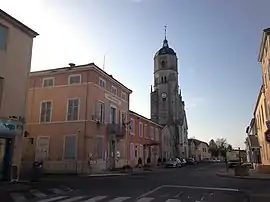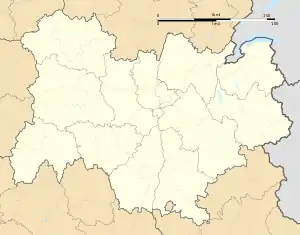Bâgé-le-Châtel | |
|---|---|
Commune | |
 Town hall and the church | |
.svg.png.webp) Coat of arms | |
Location of Bâgé-le-Châtel | |
 Bâgé-le-Châtel  Bâgé-le-Châtel | |
| Coordinates: 46°18′00″N 4°56′00″E / 46.3°N 4.9333°E | |
| Country | France |
| Region | Auvergne-Rhône-Alpes |
| Department | Ain |
| Arrondissement | Bourg-en-Bresse |
| Canton | Replonges |
| Intercommunality | Bresse et Saône |
| Government | |
| • Mayor (2020–2026) | Jean-Louis Malaterre[1] |
| Area 1 | 0.88 km2 (0.34 sq mi) |
| Population | 979 |
| • Density | 1,100/km2 (2,900/sq mi) |
| Time zone | UTC+01:00 (CET) |
| • Summer (DST) | UTC+02:00 (CEST) |
| INSEE/Postal code | 01026 /01380 |
| Elevation | 184–211 m (604–692 ft) (avg. 209 m or 686 ft) |
| 1 French Land Register data, which excludes lakes, ponds, glaciers > 1 km2 (0.386 sq mi or 247 acres) and river estuaries. | |
Bâgé-le-Châtel (French pronunciation: [bɑʒe lə ʃɑtɛl]) is a commune in the Ain department in eastern France.
History
The name of Bâgé-le-Châtel comes from a Gallo-Roman villa belonging to a certain Balgiasius.
In the Middle Ages, three parishes were formed on the territory of the Seigneurs de Bâgé: Bâgé-le-Châtel around the chateau, Saint-André where the church was built, and Bâgé-la-Ville, the largest town.
Bâgé-le-Châtel is the ancient capital of Bresse. In 1272, Bresse became part of Savoy when Sibylle de Bâgé, sole heir, married Amadeus V, Count of Savoy. Bourg (today Bourg-en-Bresse), a fortified bastion with 3400 inhabitants, became the capital of Bresse. Bâgé remained a village, whereas Bourg expanded beyond its walls to become the city of today.
Population
| Year | Pop. | ±% p.a. |
|---|---|---|
| 1968 | 568 | — |
| 1975 | 588 | +0.50% |
| 1982 | 669 | +1.86% |
| 1990 | 751 | +1.46% |
| 1999 | 762 | +0.16% |
| 2007 | 798 | +0.58% |
| 2012 | 829 | +0.77% |
| 2017 | 923 | +2.17% |
| Source: INSEE[3] | ||
See also
References
- ↑ "Répertoire national des élus: les maires" (in French). data.gouv.fr, Plateforme ouverte des données publiques françaises. 13 September 2022.
- ↑ "Populations légales 2021". The National Institute of Statistics and Economic Studies. 28 December 2023.
- ↑ Population en historique depuis 1968, INSEE